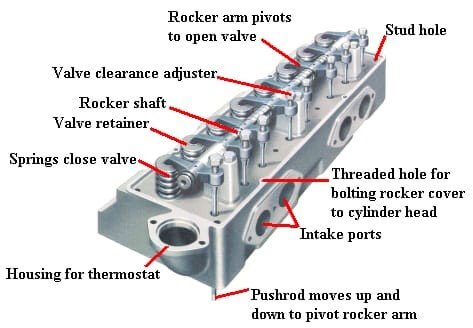The cylinder head is a specific unmoving feature of all types of internal combustion engines. Located at the top of the engine, it is fixed to the engine block using critical or captive screws that ensure accurate calibration and seal. It is the most highly loaded element in the engine.
Its main role is to enclose the top of the cylinders and its component parts are subject to high temperatures and pressures. Technical faults in the cylinder head compromise the operation of the entire engine.
What is a Cylinder Head?
In an internal combustion engine, the cylinder head sits on top of the engine block (cylinder block) and forms the roof of the combustion chamber. It’s sealed in place with the head gasket.
Inside the valve engine, the head is a simple sheet of metal. In contrast, in more modern overhead valve and overhead camshaft engines, the cylinder head is a more complex block that often contains inlet and exhaust passages, coolant passages, valves, camshafts, spark plugs, and fuel injectors.
Most straight engines have a single-cylinder head shared by all cylinders and most V engines have a two-cylinder head (one per bank of cylinders).
In all engines cooled by water – this applies to all Perkins engines – the cylinder head also contains ducts and passages.
These allow the coolant, comprising water and antifreeze, to flow and transfer excess heat away from the main body of the engine to the radiator, preventing the risk of overheating and damage. Not surprisingly, the cylinder head is subjected to extremes of temperature, which it has to resist.
Construction
Cylinder heads are made from either cast iron or cast aluminum. Cast aluminum is more expensive to produce but offers considerable weight-saving and dissipates heat better than cast iron. Virtually all production gasoline engines use an aluminum head, while cast iron is still commonly used for diesel due to its higher strength.
The interior of a cylinder head is a complex network of oil galleries and coolant passages, even more complex than the engine block. To form these interior cavities, heads are often cast using the lost-foam casting technique.
Components Of a Cylinder Head

Here are some parts descriptions of cylinder heads:
- Inlet and exhaust runners: These ensure that the air-fuel mixture gets into the combustion chamber and that exhaust gasses purge from the cylinders.
- Inlet and exhaust valves: These allow the air-fuel mixture in and the exhaust gases out of the cylinder head.
- Camshafts: Responsible for opening and closing the valves.
- Spark plugs: They initiate the combustion of the fuel.
How do Cylinder Heads work?
The cylinder head closes off the top of the cylinders to form the combustion chambers. The spark plugs protrude through the cylinder head into the combustion chambers to spark ignition. Opening into the cylinders are the valves.
An intake valve opens to allow a mixture of fuel and air into each cylinder before closing again. The piston moves up inside the cylinder to compress the air/fuel mixture. The spark plug ignites the compressed fuel.
And, as the piston moves away from the cylinder head because of the rapidly expanding gases caused during combustion, the exhaust valve opens to allow the gases to exit the engine. The cam shaft makes sure that all of this activity happens in the right timing.
Why Do Cylinder Heads Fail?
The most common reason for cylinder head failure is overheating caused by, for example, coolant loss, head gasket failure or restricted flow of coolant. In extreme cases, a cracked or damaged cylinder head can result in terminal damage to the entire engine! You must deal with any problems as soon as possible to try and prevent this from happening.
Cylinder heads can also warp because of the tremendous pressure placed on them by extreme temperature changes. This means that it is no longer providing a flat surface to hold the head gasket in the right position, which can lead to expensive problems later on in the form of major repairs or total engine replacement.
Warping is a particular problem for cylinder heads made of aluminum. Different engines have different levels of tolerance for cylinder head warping – some can withstand a high amount of warping while still working effectively. If your cylinder head does warp, you may be able to take it to a mechanic who specializes in realigning them – if not, you will probably need a replacement.
What Are the Symptoms of Cylinder Head Failure?
The symptoms of cylinder head failure are varied – it is important that drivers are able to recognize them as quickly as possible so any damage can be limited. If the cylinder head fails, it will lead to the engine (and by extension the vehicle) breaking down.
- Drop in coolant levels or coolant temperature change.
- Drop in oil levels.
- Drop in engine performance.
- Smoke is coming out of the exhaust.
The most common reason for cylinder head failure is overheating caused by coolant loss, head gasket failure or restricted flow of coolant. In extreme cases, a cracked or damaged cylinder head can result in terminal damage to the entire engine.
How Much Will Cylinder Head Repair Cost at a Garage?
The average cost for a cylinder head replacement is between $3,522 and $3,871. Labor costs are estimated between $1,217 and $1,535 while parts are priced between $2,305 and $2,337.
A cylinder head should last the lifetime of the engine. Failure to follow regularly scheduled maintenance recommended by the manufacturer – especially oil changes – can result in damage to the cylinder head, valves, and more. Allowing the engine to overheat can also damage the cylinder head.